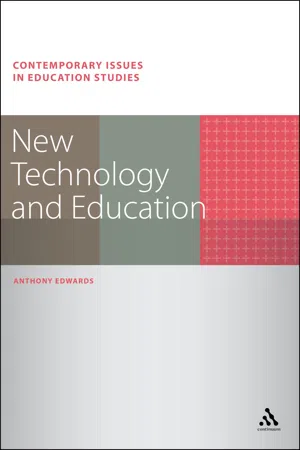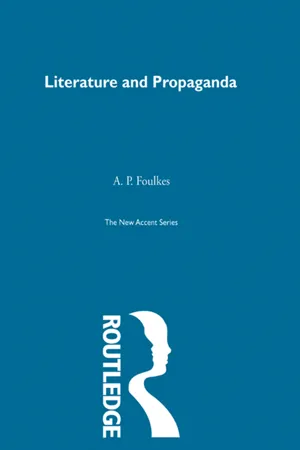Languages & Linguistics
Technological Determinism
Technological determinism is the theory that technology drives social and cultural change. It suggests that technological advancements shape and influence human behavior, language, and communication. Proponents of this theory argue that the development and use of technology have a significant impact on the way languages evolve and are used in society.
Written by Perlego with AI-assistance
Related key terms
Related key terms
1 of 4
Related key terms
1 of 3
3 Key excerpts on "Technological Determinism"
- eBook - ePub
- Anthony Edwards, Richard Race, Simon Pratt-Adams(Authors)
- 2012(Publication Date)
- Continuum(Publisher)
Their ideas were transformed into a school of thought, Determinism, which postulates that every decision and action is inevitable and is a necessary consequence of something that has happened beforehand. Technology, no matter how it is defined, is also sometimes regarded as an independent self-regulating phenomenon shaping the future despite rather than because of human aspirations and desires. This is called ‘Technological Determinism’. Although the phrase was first accredited to Veblen (1921), the idea has been around since the industrial revolution that started in eighteenth-century England. Marx has often been associated with it because his writings appear to suggest that he conceived social processes in technological and not economic terms (Bimber, 1990). It is also found in other areas of study. Psychologists sometimes use the phrase ‘biological or genetic determinism’ which, at its most benign, refers to the innate capacity of some people to develop in a particular way. Language determines thought in linguistic determinism and not the other way round. All forms of this doctrine imply that human beings have little control or responsibility for what happens and that there is an inevitable and predictable path along which things (e.g. technology) will develop. For those who believe in the most extreme or hard notion of Technological Determinism, there is no choice about how technology and, hence, society evolves. This is preordained. Some such as Kanuka (2008) argue that our experiences of the world contradict this belief. We do have choice. This has led to a softer version of Technological Determinism, which acknowledges that there are many influences on events, including human beings. Technologies in this context act as causal agents that have a pivotal role in social change, but not an exclusive one - eBook - ePub
- Michael Bailey(Author)
- 2012(Publication Date)
- Routledge(Publisher)
Section I
The technological determinist narrative
Introduction
While there is a great deal of variance in interpretation and emphasis, much of the work associated with this particular narrative has its origins in the Toronto school of media theory. Perhaps the best known advocacy for Technological Determinism is to be found in the work of Marshall McLuhan. Writing over forty years ago now, it was McLuhan (1964) who famously declared, ‘the medium is the message’. By this, McLuhan meant the essence of communication is less to do with content than it is the medium itself. Indeed, he notes that the content of any medium is always another medium: the content of writing is speech, the written word is the content of print, print is the content of the telegraph, and so on. Other luminaries include Harold Innis, Elisabeth Eisenstein and Walter Ong, among others. Between them, they painstakingly map out what are generally regarded as the major landmarks in the development of communication technologies – ranging from prehistoric oral cultures, innovations in the printing press, through to more recent advancements in electronic media – apropos their impact on the circulation of ideas, sensory experiences, interpersonal relations and socio-cultural change generally.In its most extreme form, Technological Determinism is the grandest of all master narratives, which is why it is subject to special criticism in Curran’s original essay. Echoing concerns first expressed by Raymond Williams (1974) over thirty years ago now, Curran argues that Technological Determinism is intellectually flawed because it pays too much attention to the technology of communications and too little attention to their content and the socio-historical processes in which they are located. That is to say, communication technologies are nearly always developed in the context of solving particular social needs that are historically specific (cf. Winston 1986). More crucially, such accounts tend to overlook the ways in which people themselves make history, assuming instead that technology is the primary agent of historical change. - eBook - ePub
- A. P. Foulkes(Author)
- 2013(Publication Date)
- Routledge(Publisher)
5 Linguistic determinism and literary freedomThere is a point of view known as linguistic determinism which has been associated variously with the writings of Wilhelm von Humboldt, Edward Sapir, Benjamin Whorf, Emile Durkheim and, more recently, of L. S. Vygotsky (Lyons 1968, pp. 432ff.; Cherry 1978, pp. 306ff.; Eco 1977, pp. 76ff.). The so-called Sapir-Whorf hypothesis, which represents the extreme form of linguistic determinism, holds that language does not reflect ‘reality’, but rather creates it according to the structures and limits permitted by the language of a given culture: in Sapir’s words, ‘we see and hear and otherwise experience very largely as we do because the language habits of our community predispose certain choices of interpretation’ (Whorf 1956, p. 134).Observing how linguistic factors could predominate over obvious physical ones (Whorf 1956, pp. 135ff.), and at the same time investigating the expressive possibilities of non-Indoeuropean languages, Whorf spoke of a ‘linguistically determined thought world’ which ‘not only collaborates with our cultural idols and ideals, but engages even our unconscious reactions in its patterns and gives them certain typical characters’ (Whorf 1956, p. 154). Each language ordains the forms and categories by which we not only communicate, but also analyse the external world, notice or neglect relationships and phenomena, channel reasoning and build ‘the house of consciousness’ (Whorf 1956, p. 252). The mind, in short, uses language in order to ‘make a provisional analysis of reality and then regard it as final’, and ‘Western culture has gone farthest here, farthest in determined thoroughness of provisional analysis, and farthest in determination to regard it as final’ (Whorf 1956, p. 263).Even if we accept this view, or a modified form of it known as ‘cultural relativity’ (Lyons 1968, p. 433), it does not follow that the limits of individual consciousness or the capacity for unorthodox thought are permanently imprisoned, any more than the Marxist premise that ‘being determines consciousness’ implies inevitable human passivity. As Solomon suggests, the premise should be understood as ‘the dialectical twin of the proposition that “men make their own history”’ (Solomon 1979, p. 17). The limits of consciousness may co-terminate with the boundaries of language, but these boundaries are in a constant state of flux and redefinition. Even states like Nazi Germany, which made a systematic effort to control public and private consciousness by controlling language, found that their extraordinarily detailed directives concerning language usage could swiftly be subverted by popular processes. When Goering ill-advisedly claimed that he would be called Meier (i.e. ‘I’m a Dutchman’) if a single bomb fell on Germany, it was not long before the air-raid sirens in the Ruhr were referred to locally as ‘Meier’s French horn’ (Balfour 1979, p. 433). Ritualized laughter of this kind, as Mikhail Bakhtin has persuasively argued, can serve to dissolve authoritarian commandments and clarify consciousness; it liberates not only from external censorship, but ‘first of all from the great interior censor’ (Bakhtin 1979, pp. 298, 300).
Index pages curate the most relevant extracts from our library of academic textbooks. They’ve been created using an in-house natural language model (NLM), each adding context and meaning to key research topics.
Explore more topic indexes
Explore more topic indexes
1 of 6
Explore more topic indexes
1 of 4


